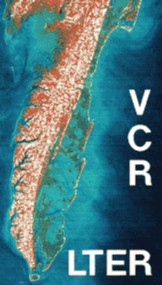 Effects of Increased Inundation and Wrack Deposition on High Salt Marsh Plants |

Patty Tolley and Bob Christian
Department of Biology
|
 Effects of Increased Inundation and Wrack Deposition on High Salt Marsh Plants |

Patty Tolley and Bob Christian
Department of Biology
|
A rise in sea level may cause an increase in inundation and in natural disturbances in high salt marshes. A nested randomized block design was used to experimentally study the impacts of increased tidal inundation and wrack deposition on Juncus roemerianus and associated high marsh plant species (i.e., Spartina patens and Distichlis spicata) in Brownsville Marsh. Increased inundation occurred during the growing season by daily pumping creek water during high tides onto the flooded plots. Wrack covered the plots for seven months from April to October, 1994. Data collected included patterns of the growth and senescence of J. roemerianus leaves in 1994 and 1995, biomass by species in 1994, and vegetative ground cover in 1994 and 1995.
Increased inundation did not affect the maximum height of J. roemerianus leaves. Also increased inundation did not affect the regrowth of J. roemerianus leaves after wrack deposition. Of the three dominant species in the plots (J. roemerianus, S. patens, and D. spicata), only S. patens had statistically lower biomass in the flooded plots as compared to the border control, but the flooded plots were not statistically different from the control plots. S. patens biomass in the border control and control plots were not statistically different. Wrack deposition was highly significant in reducing the biomass of all three species. The only significant flooding and wrack interaction was with S. patens. The two other species that were present in the plots were Spartina alterniflora and Scripus sp. Neither wrack nor increased inundation significantly affected the biomass of these two species, but these results may only be an artifact of the scarcity of these two species in the plots. When comparing the total biomass collected regardless of plant material type, wrack deposition significantly reduced the total biomass in both the J. roemerianus dominated areas and the S. patens/ D. spicata dominated areas. In the J. roemerianus dominated areas, the border control plots had significantly higher biomass then the flooded and control plots. Flooding condition did not affect the S. patens/D. spicata dominated areas. Lastly we compared the ground cover of the plots recorded in 1994 with the ground cover in 1995, there was statistically more change in the wrack areas of the plots than in the nonwrack areas. This change in ground cover was a result of plant regrowth during 1995 after the removal of wrack.
Thus the high marsh plant community appears relatively insensitive to the increased inundation imposed and very responsive to the disturbance of wrack. The only species responding negatively to flooding was S. patens, a species normally confined to the high marsh. Seven months of wrack deposition greatly reduced aboveground plant biomass. After the wrack was removed, plants recolonized the bare areas. Analysis of the plant biomass one year after the removal of wrack is under way.